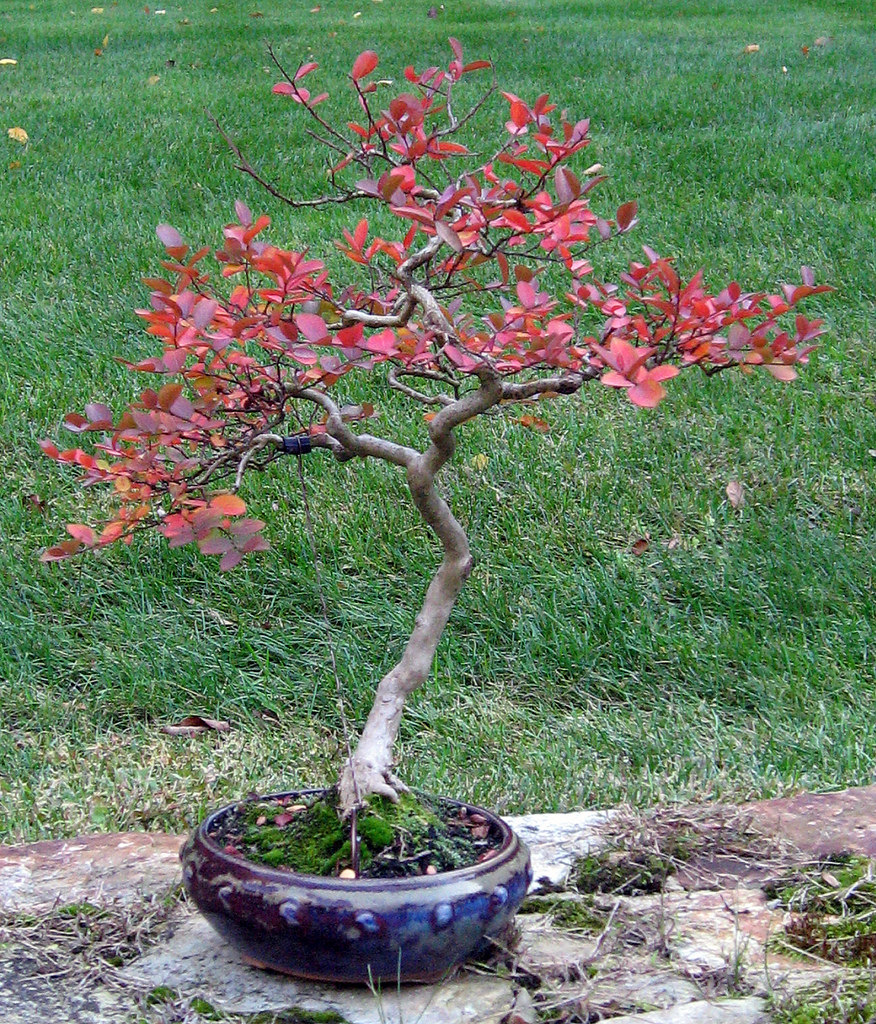We get awfully enamored with the big three of bonsai trees, namely juniper, maple and pine, and for good reason. Each of these are a source of splendid bonsai and, at least for the juniper, are very easy to grow and maintain as bonsai. We lose track of the fact that many other trees can also make very rewarding bonsai. An outstanding example is the crepe myrtle. It is not seen very often at local shows, and that is a pity.
Crepe myrtles have a lot to offer. They produce an abundant display of flowers from April to September. The flowers can range from white to pink to purple, depending on the cultivar, and have a crinkly texture, hence the name. The bark is to die for. It is nearly white, and the bark can scale off, producing a mottled visual texture. Further, the trunk is usually furrowed with many soft curves which gives natural movement to the tree. The wood is hard and durable, and can be carved readily into jins and sharis. Crepe myrtles usually produce spectacular fall leaf color as an added benefit.
Let’s look a bit closer at crepe myrtles. They are native to Asia and Australia, and are at their best in hot and humid climates. Although they have the reputation of being frost tender, not to fear. They are frequently seen locally as splendid landscape trees, at least west of the hills. During the severely cold weather that occasionally is seen east of the hills, bonsai trees might enjoy a bit of winter protection. Crepe myrtles may be found in local nurseries, but be aware of the fact that there are many cultivars available and they range from dwarfs to energetic trees that can quickly grow to thirty feet or higher. You would probably be more pleased with the dwarf varieties as bonsai.
Crepe myrtles grow readily from seed or cuttings. The trunks on the seedlings thicken only slowly  with time, but the process can be speeded up by heavily pruning them and then allowing the trees to grow freely the following year. The trees bloom on new wood which means that they can be heavily pruned at the end of summer. This is in contrast with trees that bloom on old wood where heavy pruning at the end of summer will remove the flower buds that are needed for bloom the following year.
with time, but the process can be speeded up by heavily pruning them and then allowing the trees to grow freely the following year. The trees bloom on new wood which means that they can be heavily pruned at the end of summer. This is in contrast with trees that bloom on old wood where heavy pruning at the end of summer will remove the flower buds that are needed for bloom the following year.
The biggest problem with crepe myrtles is wiring them without scarring their biggest asset, their bark. If the tree is wired, the wire should not be left on the tree for more than a very few months. Sometimes wire is tightly wrapped with paper, and this helps reduce the possibility of scarring. Guy wires are also another possibility to reduce the chance of scarring.
Placing the trees in full sun will allow the best flowering of the tree. Once the tree has flowered, removal of the old flowers can possibly produce a second crop of flowers later in the year.
So there you have it, a possible new addition for your bonsai collection. You will be delighted with what crepe myrtles have to offer.

